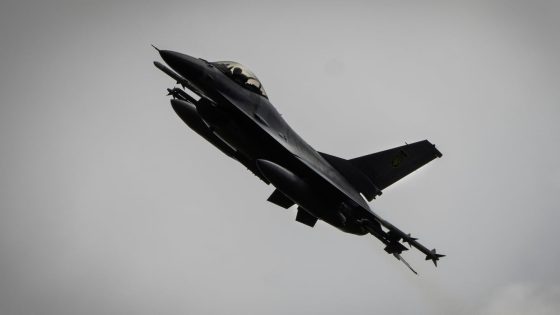In “Boy Kills World,” Bill Skarsgård has burning eyes and model cheekbones, sinewy arms popping out of a dirty red athletic vest, and a feral pout that makes him look like Jean-Claude van Damme crossed with Lou Reed. He plays a deaf-mute avenger, known only as Boy, who kills people in insanely violent ways. Yet through it all, the character retains his innocence. He’s a wounded wild child in a man’s body.
Raised on a mountain by a martial-arts trainer called the Shaman (Yayan Ruhian), who may remind you, at first, of the Zen master in “Kill Bill: Volume 2,” Boy had his past taken away from him by a vicious totalitarian regime. During the Culling, an annual ritual where law and order is maintained by the state-sanctioned execution of criminals in the street, Boy saw his little sister, Mina (Quinn Copeland), executed right in front of him. Now he’s getting his payback.
“Boy Kills World” is the first feature directed by the German-born Moritz Mohr, and he draws on a panoply of sources: video games and graphic novels, “The Hunger Games” and “The Purge,” the “John Wick” films and the decadent action fandangos of Matthew Vaughn. Yet the movie is more deliriously violent than any of them. In pursuit of his enemies, Boy slashes and gouges and decapitates. He bare-knuckle punches with a split-second intensity that magnetizes the camera to his every move. He unleashes machine-gun fire with the dexterousness of a ballistic surgeon, and he doesn’t just kick — he turns his body into a twirling homicidal battering ram. The action is the point, but it’s not the whole point; “Boy Kills World” succeeds at creating a toxic cartoon fascist world. The film’s astonishing levels of violence are about what it takes to overcome its version of evil.
If you were asked to define the difference between the films of the early ’70s and the movies of today, the answer would be obvious: Back then, a lot of movies — even those from Hollywood — had a boldness and storytelling purity and humanity; today, too many movies are overcooked franchise popcorn. Yet there’s another way to characterize the difference. In 1971, Stanley Kubrick released “A Clockwork Orange,” and it’s no exaggeration to say that it deeply shocked people. It was a singular and disturbing vision — a sociopathic dystopia — that flirted with a kind of sick-puppy voyeuristic horror. When you watched the “Singin’ in the Rain” scene, it was extending the boundaries of how transgressive a work of art could be.
So what does it mean that in a movie like “Boy Kills World,” that level of cheeky violent sadism has become not so much disturbing as it is a pure lark — the new extreme threshold of mainstream entertainment. The fact that this is what we now seek out for kicks may be scarier than anything in “A Clockwork Orange.”
Yet the pop culture of the last 50 years has primed us for it: the slasher movies, the video games, the high-body-count delirium of the “John Wick” films, which may have been the first films to package this kind of relentlessness as cutthroat jollies for the megaplex. The kill-kill-kill spirit of “John Wick” made a film like “Boy Kills World” possible, yet “Boy Kills World” takes it all a step further. It’s the action film as slasher movie as gonzo damaged-superhero movie. It’s a depraved vision, yet I got caught up in its kick-ass revenge-horror pizzazz, its disreputable commitment to what it was doing.
Boy, who can read lips, understands most of what’s happening around him, and he reacts to events by talking directly to us on the soundtrack, in an exaggerated he-man voice (like Mel Gibson’s in “Mad Max”). You could say that the movie, in a way, cheats the fact that he can’t speak, but Boy’s quips-from-his-inner-voice lend “Boy Kills World” a graphic-novel funkiness.
Boy has gone out into the world to right its wrongs, but what’s standing atop the pyramid isn’t the usual stoic power addict. It’s a dysfunctional family of rulers who are at each other’s throats. Mohr, working from a script by Tyler Burton Smith and Arend Remmers, has fun fleshing out these baroque villains. I enjoyed Brett Gelman as the bearded brother who’s like a diamond-district chiseler who thinks he’s a brilliant screenwriter, and Famke Janssen as the matriarch who’s losing her mind. As the dynasty’s media ringleader, Sharlto Copley does his showboat thing (and gets what he deserves). Mohr stages one spectacular sequence — the slaughterhouse version of a winter-wonderland television commercial — that would make Alex from “A Clockwork Orange” applaud in glee.
There’s a big twist — or really, two in one. The state soldier, named June27 (Jessica Rothe), who speaks in slogans flashed onto her digital combat visor turns out to be closer to home than we think. And a character we assume is heroic is revealed to be an emotionally broken monster. All of that succeeds in holding our attention, and the climactic fight — a threesome — is shot and choreographed with brutal visual wizardry. It’s all held together by Skarsgård’s performance, and the trick of it is that you never catch him playing dumb. Yet Boy is often a beat behind what’s happening. That’s what makes us warm up to him; he’s a blood-spattered avenger in spite of himself. He turns the old ultraviolence into child’s play.
Source Agencies




